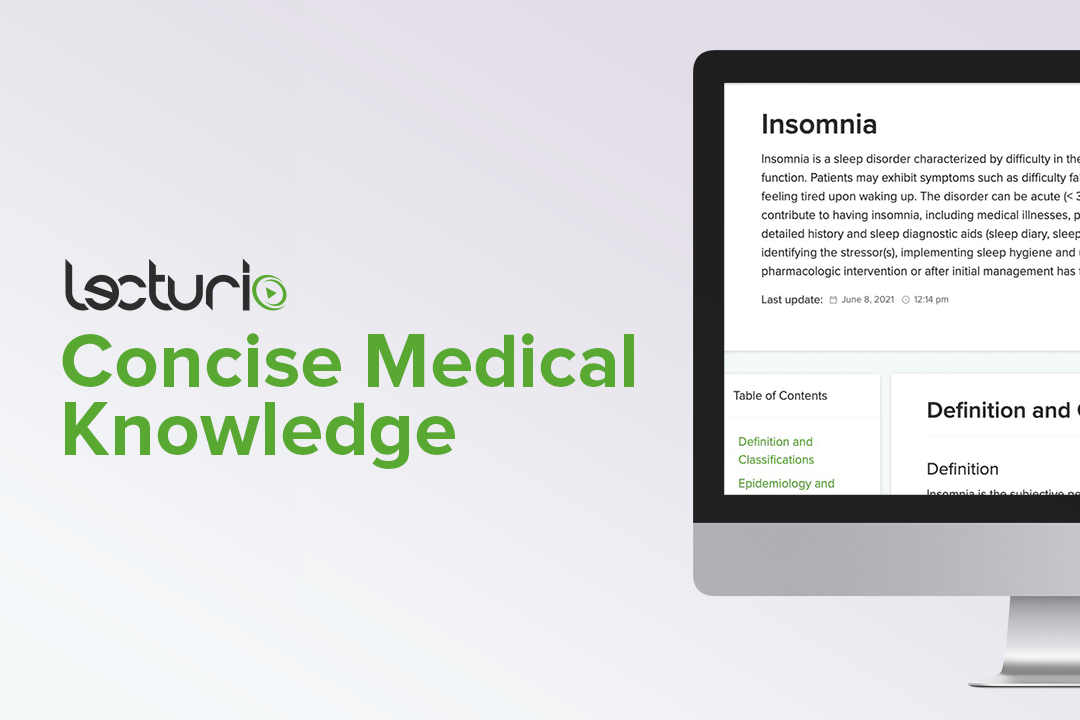Playlist
Show Playlist
Hide Playlist
Insomnia: Diagnosis
-
Slides Sleep Disorders Insomnia.pdf
-
Download Lecture Overview
00:00 How do we diagnose insomnia? Well, we look for a number of symptoms, difficulty falling asleep, daytime sleepiness or excessive daytime sleepiness, fatigue and tiredness can be seen, problems with concentration or memory can actually be some of the presenting symptoms of insomnia, and memory dysfunction or cognitive dysfunction can indicate further evaluation of the patient's sleep and be the underlying cause. Irritability and increased errors or accidents at work or other activities may herald symptoms that are indicative of an underlying sleep disorder. 00:36 When we think about the diagnosis of sleep, the DSM 5 has a series of criteria that are used to diagnose an insomnia disorder. The first is difficulty initiating or maintaining sleep or early morning awakening without being able to return to sleep. We look for social, occupational, and behavioral impairment which is a critical part of the diagnosis of an insomnia disorder. Symptoms should be present for at least 3 nights per week and symptoms should be noticed for at least 3 months. 01:08 Sleep difficulty present despite having ample opportunity for sleep should be present. Sleep disturbances cannot be explained by any other sleep-wake disorders. We want to exclude other potential causes. And then sleep difficulty should not be due to physiologic effects of substance use or mental health disorders or other medical conditions. We want to rule out other causes particularly those that are treatable or reversible of these symptoms. In terms of diagnosis, we can use a number of diagnostic aids to help support a diagnosis of an insomnia disorder and the first is history. A comprehensive medical and psychiatric history is important in these patients. We want to take a sleep history and really interrogate the time of onset of sleep, the maintenance and adequacy of sleep, and symptoms around awakening. And we can also interview not just the patient but a bed partner about the quality and quantity of sleep. In terms of physical exam, this can help evaluate comorbid conditions and rule out other potential explanations. Self-reported screening tools can also be helpful and evaluate problems with sleep, sleep quality or sleep duration. And then a sleep diary can be helpful. It's typically kept over the course of 2-4 weeks where the patient records the time of onset of sleep, when they get in the bed, when they tend to fall asleep, their sleep maintenance or awakenings during the night, and when they get up for their daytime. The Epworth Sleepiness Scale is one of the most pervasive scales used to evaluate patients with symptoms of excessive daytime sleepiness. A series of questions evaluates the patient''s sleepiness during the day and can be used to stratify potential causes of sleep dysfunction and the presence of sleep dysfunction. 02:57 And then lastly, polysomnography or evaluation of sleep is, it can be helpful in the diagnosis of an insomnia disorder but is not required. This is utilized really to evaluate alternative explanations for the insomnia as opposed to confirm a diagnosis of insomnia disorder. Here, we see the Epworth Sleepiness Scale, which is a really important self-administered scale to evaluate the degree of excessive daytime sleepiness. One of the most prominent symptoms of an insomnia disorder is excessive daytime sleepiness and this is how we evaluate and stratify those symptoms. Patients are asked a series of questions about how likely they are to sleep in a number of different settings such as sitting and reading or watching television or sitting in a public place or sitting in a car as a passenger lying down to rest, sitting and talking to someone, sitting quietly after lunch without alcohol, or being in a car when stopped for a few minutes in traffic. Patients rate each of these questions on a scale 0 that this would never happen or they would never doze off. 04:02 One, there is a slight chance of dozing during this activity, 2 a moderate chance, and 3 a high chance of dozing off or sleeping with this activity. A score of 10 or more suggest the presence of excessive daytime sleepiness and should warrant evaluation of an underlying sleep disorder. What other diagnostic tools can be used to evaluate patient's sleep, sleep onset, sleep quality, or sleep quantity? The Pittsburg Sleep Quality Index is an important self-administered, self-reported scale to evaluate sleep quality. And actigraphy watches can evaluate the quantity, onset, and duration of sleep and be helpful in objectively evaluating what's happening in a patient's home.
About the Lecture
The lecture Insomnia: Diagnosis by Roy Strowd, MD is from the course Sleep Disorders.
Included Quiz Questions
What is a common substance that should be asked about when evaluating a patient with insomnia?
- Caffeine
- Ginseng
- Kava kava
- Ginger
- Fatty foods
What factor is an important consideration in the DSM-5 criteria for insomnia?
- Social, occupational, or behavioral impairment
- Symptoms noted for at least one month
- Symptoms for at least one night per week
- Sleep disturbance explained by a specific sleep–wake disorder
- Sleep disturbance attributed to poor sleep hygiene or substance use
Which self-administered test may be most useful in the evaluation of a patient with insomnia and without evidence of cognitive impairment?
- Epworth Sleepiness Scale
- Montreal Cognitive Assessment
- Mini–Mental Status Exam
- NIHSS
- Get-up-and-go test
Customer reviews
5,0 of 5 stars
| 5 Stars |
|
5 |
| 4 Stars |
|
0 |
| 3 Stars |
|
0 |
| 2 Stars |
|
0 |
| 1 Star |
|
0 |




